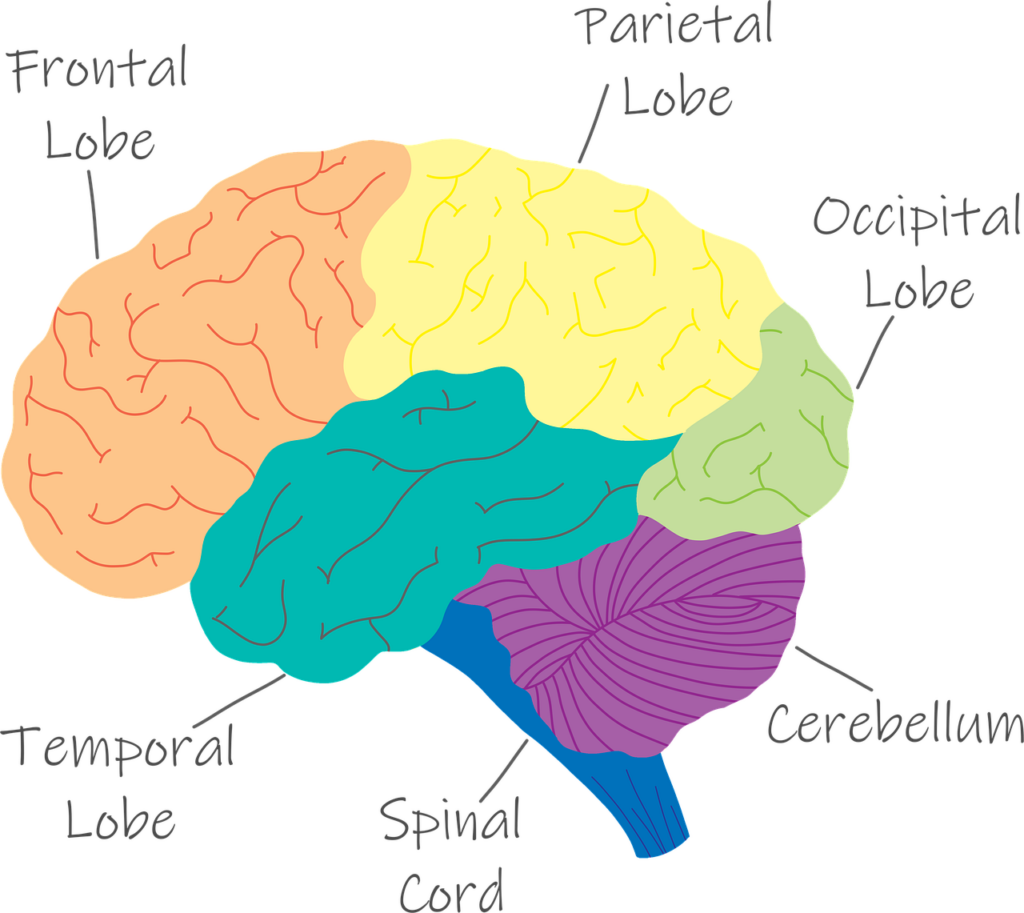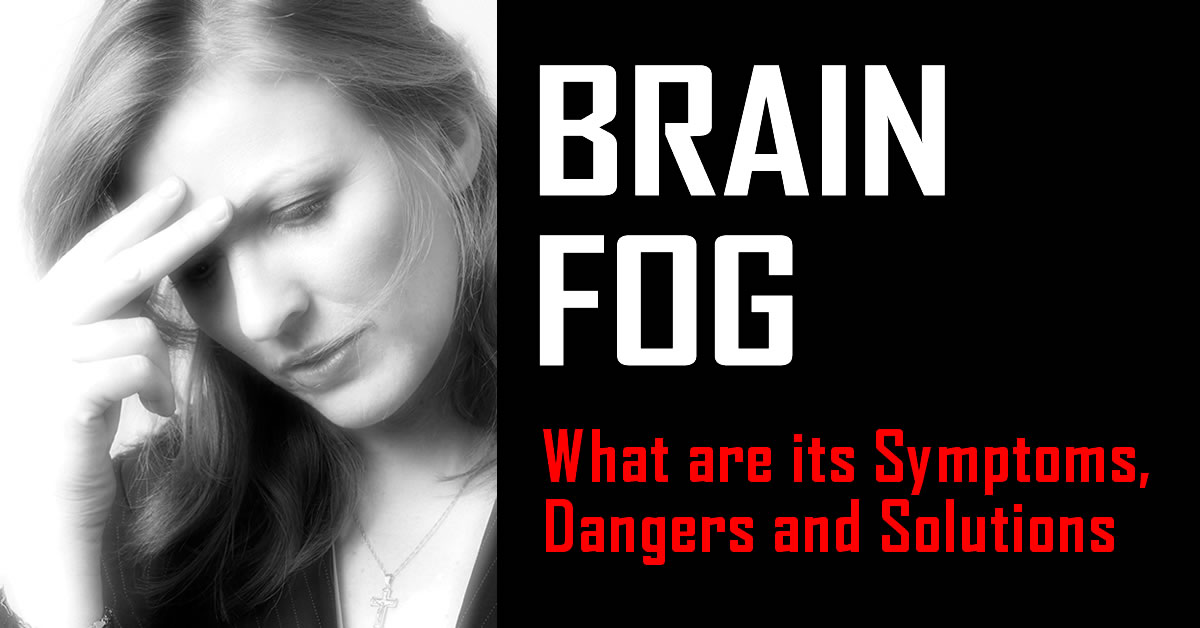What is Brain Fog, the Symptoms, Dangers and Solutions
Based on peer reviewed studies, it appears that brain fog is a reported symptom in some individuals after receiving the COVID-19 vaccine. Cases of autoimmune encephalitis and post-vaccinal encephalitis have been documented[i], often presenting with symptoms such as disorientation, amnesia, and forgetfulness.
 A survey of 241 individuals who self-reported post-vaccination syndrome (PVS) found that 63% experienced brain fog as one of their symptoms. “The five most common symptoms were exercise intolerance (71%), excessive fatigue (69%), numbness (63%), brain fog (63%), and neuropathy (63%)”. Further the week before the survey was completed by the individuals, the participants reported feeling unease (93%), fearfulness (82%), and overwhelmed by worries (81%), as well as feelings of helplessness (80%), anxiety (76%), depression (76%), hopelessness (72%), and worthlessness (49%) at least once[ii].
A survey of 241 individuals who self-reported post-vaccination syndrome (PVS) found that 63% experienced brain fog as one of their symptoms. “The five most common symptoms were exercise intolerance (71%), excessive fatigue (69%), numbness (63%), brain fog (63%), and neuropathy (63%)”. Further the week before the survey was completed by the individuals, the participants reported feeling unease (93%), fearfulness (82%), and overwhelmed by worries (81%), as well as feelings of helplessness (80%), anxiety (76%), depression (76%), hopelessness (72%), and worthlessness (49%) at least once[ii].
It is essential to note that these reports are anecdotal and may not represent the majority of vaccine recipients. The exact mechanisms underlying these symptoms are unclear and may be related to individual factors, such as underlying health conditions or immune responses.
Brain fog is characterized by cognitive impairments that can affect daily functioning. It can be temporary or chronic[iii], depending on the underlying cause. It’s often described as a feeling of mental cloudiness, lack of clarity, or sluggish thinking. Here’s a comprehensive overview of brain fog, including its symptoms and dangers:
Brain fog can result from a variety of factors, including:
- Lifestyle Factors:
- Medical Conditions:
- Medications and Treatments:
- Infections and Illnesses:
- Environmental Factors:
Symptoms of Brain Fog. Brain fog manifests through various cognitive and physical symptoms, including:
- Cognitive Symptoms:
- Physical Symptoms:
- Emotional and Psychological Symptoms:
Dangers of Brain Fog. While brain fog itself is not life-threatening, it can significantly impact an individual’s quality of life and daily functioning. The dangers associated with brain fog include:
- Reduced Productivity: Brain fog can make it difficult to perform tasks efficiently, leading to decreased productivity at work or school[xliv].
- Safety Risks: Impaired cognitive function can increase the risk of accidents, such as driving mishaps or workplace injuries[xlv].
- Emotional Distress: The frustration and anxiety caused by cognitive difficulties can lead to emotional distress, potentially exacerbating mental health issues[xlvi].
- Social Impact: Difficulty in communicating and remembering important information can strain personal relationships[xlvii].
- Long-Term Health Effects: Chronic brain fog may indicate an underlying health issue that needs to be addressed. Ignoring it can lead to more serious health problems over time[xlviii].
NEXT: Managing and Healing Brain Fog
NEXT>>>
Citations
[i] Huang YF, Ho TC, Chang CC, Shen DH, Chan HP, Chuang KP, Tyan YC, Yang MH. A Rare Adverse Effect of the COVID-19 Vaccine on Autoimmune Encephalitis. Vaccines (Basel). 2022 Jul 13;10(7):1114. doi: 10.3390/vaccines10071114. PMID: 35891278; PMCID: PMC9319671.
[ii] Krumholz HM, Wu Y, Sawano M, Shah R, Zhou T, Arun AS, Khosla P, Kaleem S, Vashist A, Bhattacharjee B, Ding Q, Lu Y, Caraballo C, Warner F, Huang C, Herrin J, Putrino D, Hertz D, Dressen B, Iwasaki A. Post-Vaccination Syndrome: A Descriptive Analysis of Reported Symptoms and Patient Experiences After Covid-19 Immunization. medRxiv [Preprint]. 2023 Nov 10:2023.11.09.23298266. doi: 10.1101/2023.11.09.23298266. PMID: 37986769; PMCID: PMC10659483.
[iii] https://www.osfhealthcare.org/blog/covid-19-vaccine-and-lingering-symptoms/
[iv] Reference: Higdon, J. V., & Frei, B. (2006). “Is there a role for antioxidant vitamins in the prevention of cardiovascular diseases? Evidence from randomized controlled trials.” Cardiovascular Research, 71(2), 214-221. doi:10.1016/j.cardiores.2006.02.005.
[v] Walker, M. P. (2009). “The role of sleep in cognition and emotion.” Annals of the New York Academy of Sciences, 1156(1), 168-197. doi:10.1111/j.1749-6632.2009.04416.x.
[vi] McEwen, B. S. (2007). “Physiology and neurobiology of stress and adaptation: Central role of the brain.” Physiological Reviews, 87(3), 873-904. doi:10.1152/physrev.00041.2006.
[vii] Salvagioni, D. A. J., Melanda, F. N., Mesas, A. E., González, A. D., Gabani, F. L., & Andrade, S. M. de. (2017). “Physical, psychological and occupational consequences of job burnout: A systematic review of prospective studies.” PLOS ONE, 12(10), e0185781. doi:10.1371/journal.pone.0185781.
[viii] Hillman, C. H., Erickson, K. I., & Kramer, A. F. (2008). “Be smart, exercise your heart: Exercise effects on brain and cognition.” Nature Reviews Neuroscience, 9(1), 58-65. doi:10.1038/nrn2298.
[ix] Fukuda, K., Straus, S. E., Hickie, I., Sharpe, M. C., Dobbins, J. G., & Komaroff, A. (1994). “The chronic fatigue syndrome: a comprehensive approach to its definition and study.” Annals of Internal Medicine, 121(12), 953-959. doi:10.7326/0003-4819-121-12-199412150-00009.
[x] Clauw, D. J. (2014). “Fibromyalgia: A clinical review.” JAMA, 311(15), 1547-1555. doi:10.1001/jama.2014.3266.
[xi] McDermott, M. T. (2009). “Hypothyroidism.” Annals of Internal Medicine, 151(11), ITC6-1. doi:10.7326/0003-4819-151-11-200912010-01006.
[xii] Weber, M. T., Mapstone, M., & Staskiewicz, J. (2010). “Cognitive changes during the menopausal transition.” Menopause, 17(4), 800-807. doi:10.1097/gme.0b013e3181d769c7.
[xiii] Hanly, J. G. (2005). “Cognitive dysfunction in systemic lupus erythematosus.” Journal of Rheumatology, 32(3), 390-397. doi:10.3899/jrheum.040706.
[xiv]Wessels, J. A. M., Huizinga, T. W. J., & Guchelaar, H. J. (2008). “Recent insights in the pharmacological actions of methotrexate in the treatment of rheumatoid arthritis.” Rheumatology, 47(3), 249-255. doi:10.1093/rheumatology/kem341.
[xv] Falleti, M. G., Sanfilippo, A., Maruff, P., Weih, L., & Phillips, K. A. (2005). “The nature and severity of cognitive impairment associated with adjuvant chemotherapy in women with breast cancer: A meta-analysis of the current literature.” Brain and Cognition, 59(1), 60-70. doi:10.1016/j.bandc.2005.05.001.
[xvi] Evered, L., Silbert, B., Knopman, D. S., Scott, D. A., DeKosky, S. T., Rasmussen, L. S., … & Ottens, T. H. (2018). “Recommendations for the nomenclature of cognitive change associated with anaesthesia and surgery—2018.” British Journal of Anaesthesia, 121(5), 1005-1012. doi:10.1016/j.bja.2017.11.087.
[xvii] Nalbandian, A., Sehgal, K., Gupta, A., Madhavan, M. V., McGroder, C., Stevens, J. S., … & Wan, E. Y. (2021). “Post-acute COVID-19 syndrome.” Nature Medicine, 27(4), 601-615. doi:10.1038/s41591-021-01283-z.
[xviii] Nalbandian, A., Sehgal, K., Gupta, A., Madhavan, M. V., McGroder, C., Stevens, J. S., … & Wan, E. Y. (2021). Post-acute COVID-19 syndrome. Nature Medicine, 27(4), 601-615. DOI: 10.1038/s41591-021-01283-z
[xix] Graham, E. L., Clark, J. R., Orban, Z. S., Lim, P. H., Szymanski, A. L., Taylor, C., Koralnik, I. J. (2021). Persistent neurologic symptoms and cognitive dysfunction in non-hospitalized Covid-19 ‘long haulers’. Journal: Annals of Clinical and Translational Neurology, 8(5), 1073-1085. DOI: 10.1002/acn3.51350
[xx] Taquet, M., Geddes, J. R., Husain, M., Luciano, S., & Harrison, P. J. (2021). 6-month neurological and psychiatric outcomes in 236,379 survivors of COVID-19: a retrospective cohort study using electronic health records. Journal: The Lancet Psychiatry, 8(5), 416-427. DOI: 10.1016/S2215-0366(21)00084-5
[xxi] Mazza, M. G., De Lorenzo, R., Conte, C., Poletti, S., Vai, B., Bollettini, I., Benedetti, F. (2020) Anxiety and depression in COVID-19 survivors: Role of inflammatory and clinical predictors. Journal: Brain, Behavior, and Immunity, 89, 594-600. DOI: 10.1016/j.bbi.2020.07.037
[xxii] Al-Aly, Z., Xie, Y., & Bowe, B. (2021). High-dimensional characterization of post-acute sequelae of COVID-19. Journal: Nature, 594(7862), 259-264. DOI: 10.1038/s41586-021-03553-9
[xxiii] Short, K. R., Kroeze, E. J. B. V., Fouchier, R. A. M., & Kuiken, T. (2014). “Pathogenesis of influenza-induced acute respiratory distress syndrome.” The Lancet Infectious Diseases, 14(1), 57-69. doi:10.1016/s1473-3099(13)70286-x.
[xxiv] Fallon, B. A., & Nields, J. A. (1994). “Lyme disease: A neuropsychiatric illness.” The American Journal of Psychiatry, 151(11), 1571-1583. doi:10.1176/ajp.151.11.1571.
[xxv] Mutter, J., Naumann, J., Schneider, R., Walach, H., & Haley, B. (2005). “Mercury and autism: Accelerating evidence?” Neuroendocrinology Letters, 26(5), 439-446. PMID: 16264412.
[xxvi] Marshall, P. S., O’Hara, C., & Steinberg, P. (2000). “Effects of seasonal allergic rhinitis on fatigue levels and mood.” Psychosomatic Medicine, 62(5), 684-691. doi:10.1097/00006842-200009000-00010.
[xxvii] Lezak, M. D., Howieson, D. B., Bigler, E. D., & Tranel, D. (2012). “Neuropsychological Assessment.” Oxford University Press.
[xxviii] Casaletto, K. B., & Ober, B. A. (2018). “Advances in memory assessment.” Annual Review of Clinical Psychology, 14, 33-60. doi:10.1146/annurev-clinpsy-050817-084917.
[xxix] Chaudhuri, A., & Behan, P. O. (2004). “Fatigue in neurological disorders.” The Lancet, 363(9413), 978-988. doi:10.1016/S0140-6736(04)15794-2.
[xxx] DeLuca, J., & Kalmar, J. H. (2008). “Information processing speed in clinical populations.” In Processing Speed: A Review and a Theoretical Framework. Journal of the International Neuropsychological Society, 14(1), 28-38.
[xxxi] Stuss, D. T., & Knight, R. T. (Eds.). (2013). “Principles of Frontal Lobe Function.” Oxford University Press.
[xxxii] Young, A. S., & Klap, R. (2010). “Confusion and disorientation.” The Journal of Clinical Psychiatry, 71(3), 327-333. doi:10.4088/JCP.9101br3c.
[xxxiii] Finkelstein, J., Lapshin, O., & Castro, H. (2010). “Computer-based administration of the Symbol Digit Modalities Test in multiple sclerosis.” Computers in Biology and Medicine, 40(1), 87-95. doi:10.1016/j.compbiomed.2009.11.002.
[xxxiv] Rains, J. C., & Poceta, J. S. (2010). “Sleep and headache.” Current Treatment Options in Neurology, 12(1), 1-15. doi:10.1007/s11940-009-0055-x.
[xxxv] Morin, C. M., & Benca, R. (2012). “Chronic insomnia.” The Lancet, 379(9821), 1129-1141. doi:10.1016/S0140-6736(11)60750-2.
[xxxvi] Wessely, S., & Powell, R. (1989). “Fatigue syndromes: a comparison of chronic ‘postviral’ fatigue with neuromuscular and affective disorders.” Journal of Neurology, Neurosurgery & Psychiatry, 52(8), 940-948. doi:10.1136/jnnp.52.8.940.
[xxxvii] Jason, L. A., Evans, M., Brown, M., & Porter, N. (2010). “What is fatigue? Pathological and nonpathological fatigue.” PM&R, 2(5), 327-331.
[xxxviii] Colenbrander, A. (2002). “Visual standards: aspects and ranges of vision loss with emphasis on population surveys.” World Health Organization.
[xxxix] Harmer, C. J., Duman, R. S., & Cowen, P. J. (2017). “How do antidepressants work? New perspectives for refining future treatment approaches.” The Lancet Psychiatry, 4(5), 409-418. doi:10.1016/S2215-0366(17)30015-9.
[xl] Hofmann, S. G., Asnaani, A., Vonk, I. J., Sawyer, A. T., & Fang, A. (2012). “The efficacy of cognitive behavioral therapy: A review of meta-analyses.” Cognitive Therapy and Research, 36(5), 427-440. doi:10.1007/s10608-012-9476-1.
[xli] Malhi, G. S., Mann, J. J. (2018). “Depression.” The Lancet, 392(10161), 2299-2312. doi:10.1016/S0140-6736(18)31948-2.
[xlii] Treadway, M. T., & Zald, D. H. (2011). “Reconsidering anhedonia in depression: Lessons from translational neuroscience.” Neuroscience & Biobehavioral Reviews, 35(3), 537-555. doi:10.1016/j.neubiorev.2010.06.006.
[xliii] Reddy, M. S. (2010). “Depression: The disorder and the burden.” Indian Journal of Psychological Medicine, 32(1), 1-2. doi:10.4103/0253-7176.70510.
[xliv] Baethge, A., Rigotti, T., & Roe, R. A. (2015). “Just more of the same, or different? An integrative theoretical framework for the study of cumulative interruptions at work.” European Journal of Work and Organizational Psychology, 24(2), 308-323. doi:10.1080/1359432X.2014.897943.
[xlv] Shirom, A., Nirel, N., & Vinokur, A. D. (2006). “Overload, autonomy, and burnout as predictors of physicians’ quality of care.” Journal of Occupational Health Psychology, 11(4), 328-342. doi:10.1037/1076-8998.11.4.328.
[xlvi] Snyder, H. R. (2013). “Major depressive disorder is associated with broad impairments on neuropsychological measures of executive function: A meta-analysis and review.” Psychological Bulletin, 139(1), 81-132. doi:10.1037/a0028727.
[xlvii] Cacioppo, J. T., & Cacioppo, S. (2014). “Social relationships and health: The toxic effects of perceived social isolation.” Social and Personality Psychology Compass, 8(2), 58-72. doi:10.1111/spc3.12087.
[xlviii] Berkman, L. F., & Kawachi, I. (2000). “Social Epidemiology.” Oxford University Press.

